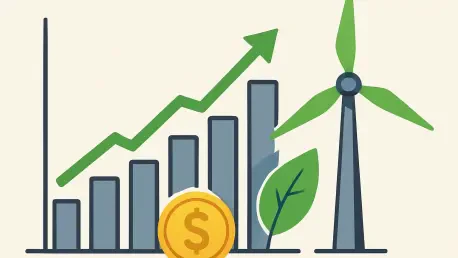In the first half of this year, clean energy investment in the United States stands at a staggering $86 billion, a figure that underscores the sector’s vitality even as it navigates turbulent policy waters. The landscape has been dramatically reshaped by recent legislative changes under the Trump administration, particularly with the enactment of the One Big Beautiful Bill Act (OBBBA), which has curtailed tax credits for cornerstone technologies like wind and solar. This scenario raises pressing questions about the adaptability of an industry critical to national energy goals.
The uncertainty stemming from such policy shifts poses significant challenges for investors and developers who have long relied on stable incentives to fuel growth. As traditional sectors face headwinds, the central inquiry emerges: how is the clean energy sector responding to these abrupt changes? Moreover, what emerging trends signal resilience and a strategic pivot in investment focus amidst this evolving regulatory framework?
This exploration seeks to unravel the dynamics at play, examining whether the industry can sustain its momentum by diversifying into new technologies. Key indicators suggest a broader adaptation strategy, prompting a deeper look into how market participants are recalibrating their approaches to align with the current political and economic realities.
Background and Importance of Policy Impacts on Clean Energy
Historically, clean energy investment has thrived on robust federal support, with tax credits and incentives under prior legislation like the Inflation Reduction Act playing a pivotal role in scaling projects. These mechanisms provided a financial backbone for wind and solar, enabling rapid deployment and fostering innovation across the sector. Their influence extended beyond mere funding, shaping market confidence and long-term planning for energy infrastructure.
However, the recent policy landscape, marked by the OBBBA, has introduced significant disruptions by scaling back support for these traditional pillars. The reduction in tax credits specifically targets wind and solar, sectors that have been linchpins of renewable growth, thereby altering the investment calculus for many stakeholders. Such changes signal a shift in governmental priorities, challenging the industry to find new pathways to profitability and expansion.
The broader significance of these shifts cannot be overstated, as clean energy remains integral to meeting rising energy demands and achieving climate objectives. Additionally, the sector supports domestic manufacturing and job creation, making its stability a matter of economic and national security. Understanding the interplay between policy and investment is thus essential for grasping how the United States can maintain progress toward sustainable energy goals amidst political flux.
Research Methodology, Findings, and Implications
Methodology
The analysis of clean energy investment trends in the first half of this year draws on comprehensive data compiled by a leading finance technology company specializing in tax credit transactions. This evaluation focuses on investment volumes, market dynamics, and the transactional flow of tax credits across a spectrum of clean energy technologies. A meticulous approach ensures a granular understanding of how policy changes ripple through various segments.
Key metrics include project finance lending figures, the scale of transferable tax credit markets, and shifts in technology-specific investments. The methodology also incorporates qualitative insights through expert commentary from industry leaders, providing context to numerical trends. This dual perspective aids in painting a holistic picture of the sector’s current state and its adaptive strategies.
Data collection emphasizes real-time market responses, capturing the immediate impact of legislative changes on investor behavior. By synthesizing quantitative benchmarks with informed opinions, the research offers a robust framework for assessing both challenges and opportunities within the clean energy investment arena.
Findings
A standout revelation from the data is the increase in clean energy project finance lending, reaching $86 billion in the first half of this year, compared to $80 billion in the corresponding period last year. This growth reflects a persistent investor appetite despite regulatory uncertainties. The figure highlights an underlying confidence in the sector’s potential to deliver returns even under constrained conditions.
Equally notable is the doubling of the transferable tax credit market, which now exceeds $20 billion, fueled by robust activity in energy storage and nascent fields like nuclear and advanced manufacturing. However, traditional sectors face stark declines, with wind production tax credits sold plummeting from 33.0% to 9.5% of the market share, and solar credits grappling with early phase-outs and stringent new restrictions. These disparities underscore uneven policy impacts across technologies.
Diversification emerges as a defining trend, with significant upticks in investments toward geothermal, clean fuels, and energy storage. These areas benefit from relatively preserved incentives and growing bipartisan support, positioning them as critical buffers against the setbacks experienced by wind and solar. This strategic shift illustrates a market proactively seeking stability through broader technological engagement.
Implications
The trend of diversification fortifies the clean energy sector’s resilience, mitigating the risks posed by policy volatility. By spreading investments across a wider array of technologies, the industry ensures sustained funding for essential energy infrastructure, safeguarding long-term energy security. This adaptability is a bulwark against the unpredictability of legislative support.
Nevertheless, the rollback of incentives for wind and solar portends potential financial distress for developers who structured their models around previous tax benefits. The long-term viability of projects in these sectors may be jeopardized without alternative funding mechanisms or policy reversals. Such challenges could slow progress in areas historically central to renewable energy expansion.
On a positive note, the pivot to emerging technologies like advanced manufacturing offers substantial societal and economic advantages. Growth in these areas promises job creation and bolsters domestic production capabilities, aligning with national priorities for economic resilience. These developments suggest that policy headwinds, while disruptive, may catalyze innovation and broader industrial benefits over time.
Reflection and Future Directions
Reflection
Navigating the intersection of policy pressures and market demands reveals a complex landscape where predicting outcomes remains challenging. The interplay of reduced tax credits with persistent energy needs creates cross-cutting forces that obscure the net impact on clean energy investment. This complexity necessitates a cautious approach to forecasting sector-wide trajectories.
Limitations in current analyses include a conservative outlook for the latter half of this year, driven by diminished buyer interest in future-year tax credits. Such trends could constrict the market’s growth if tax liabilities continue to influence bidding behaviors negatively. Acknowledging these constraints is vital for a balanced understanding of the industry’s near-term prospects.
A key insight lies in the adaptive strategies employed by market participants, who demonstrate agility in pivoting toward technologies with stronger policy backing. This responsiveness highlights an industry not merely reacting to setbacks but actively reshaping its focus to capitalize on available opportunities. Such dynamism is a testament to the sector’s underlying strength.
Future Directions
Further investigation into the enduring effects of policy shifts on specific clean energy segments, particularly recovery mechanisms for wind and solar, is warranted. Understanding how these sectors can rebound or restructure under diminished support will be crucial for maintaining a balanced renewable portfolio. Targeted studies could illuminate viable paths forward.
Exploring bipartisan support mechanisms for critical minerals and biofuels presents another avenue for research. These areas, often less affected by partisan divides, may offer stable investment channels that sustain sector growth. Assessing their potential to anchor clean energy financing amid broader uncertainties could yield actionable policy recommendations.
Monitoring the expansion of energy storage and advanced manufacturing is also recommended, given their emerging dominance in investment portfolios. Tracking their growth trajectory over the coming years, from this year to 2027, will help determine whether they can solidify as primary drivers of clean energy progress. Such insights will inform strategic planning for both investors and policymakers.
Conclusion: Navigating a Shifting Landscape in Clean Energy Investment
The examination of clean energy investment in the first half of this year revealed a sector that, despite policy-induced challenges, exhibited remarkable resilience with $86 billion in project finance lending and a transferable tax credit market surpassing $20 billion. The pronounced shift toward diversification, especially into energy storage and emerging technologies, mitigated the adverse effects of policy rollbacks on traditional sectors like wind and solar. This adaptability underscored a pivotal moment of transformation within the industry.
Looking ahead, stakeholders should prioritize fostering innovation in underrepresented technologies while advocating for stabilizing policies that can cushion vulnerable segments. Establishing collaborative frameworks between public and private entities could accelerate the development of alternative funding models, ensuring that even underfunded sectors retain momentum. Additionally, investing in research to enhance the scalability of storage and manufacturing solutions emerged as a critical next step to solidify these areas as cornerstones of future energy systems.
Ultimately, the path forward demands a proactive stance—leveraging current growth areas to build a more robust and inclusive clean energy ecosystem. By aligning investment strategies with evolving policy landscapes and technological advancements, the sector can transform short-term obstacles into long-term opportunities. This strategic focus promises not only to sustain but also to elevate the role of clean energy in shaping a sustainable national energy future.









